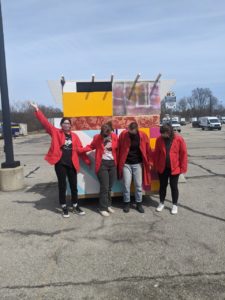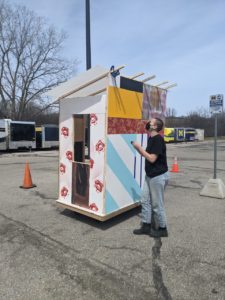
Imagine a sun shelter held aloft by 100 people to shield asylum seekers, or a telescoping ladder constructed to circumvent surveillance cameras. Art interventions and tactical media, alternative festivals, temporary communities and electoral guerrilla theater organized online and practiced off–line are all potential ways to prefigure the world we want to live in. We will build physical and virtual structures to foster social connection.
The occupation of Tahrir Square in Egypt, the encampments in public squares across Spain by the Indignados movement, the Occupy encampments across the world are prefigurative interventions, providing microcosms of spaces in which people create the world they want to bring into being.
Given the ON/OFF-line worlds in which actions occur—both pre and post COVID-how do peoples’ behaviors in those spaces intersect with one another? What makes certain individuals (1) participate and “like” or “follow” a direct call to physically act or demonstrate in the offline world and other individuals (2) “like” and/or “follow” a group or movement by virtue of a mouse-click? Are behaviors of slacktivism (feel-good social cause actions and online petitions), early tech adopters, or viral videos paralleled in real time and space? Can prefigurative interventions be generated online and enacted offline to address social connections?
Together, this UARTS Faculty Engineering/Arts Student Team (FEAST) and I will create physically and socially intelligent structures that facilitate cooperation, emotional release and transcend the expectations of architecture and infrastructure as fixed, emboldening viewers to become participants. In his scholarship of social movement via the internet Brett Rolfe (Rolfe, 2005) introduces the idea of “innovative hothouses” –small and specialized pioneering communities which aim at exploiting all opportunities of that medium. With means such as mail-bombing or net strikes, these innovations are deployed by activist artists and other groups adding to the repertoire of online social forums, we seek to articulate a concept akin to the hothouse metaphor to demonstrate the impact of artists’ practices on collective action offline and online.
During the initial phase of this project, the team will generate many ideas, many images and building an energy that says “yes let’s try that.” We will then aim to get some of these ideas out into the world soon–certainly late fall 2021 –to test. We will generate images, physical and digital models, seek public exhibition and publication opportunities and build the world we want to see.
Faculty Project Lead
 Prior to his appointment at the School of Art & Design in 2003, Nick Tobier spent four years as assistant professor at the School of Art at Alfred. From 1996 to 1998, he studied landscape architecture at Harvard’s Graduate School of Design and subsequently worked in professional practice at Landworks Studio/Boston and the NYC Department of Parks & Recreation/Bronx Division as a designer. He served as project manager for Storefront for Art and Architecture, writing critical essays, facilitating public projects and coordinating international competitions as he conducted broad-thinking explorations of architecture and urban space beyond expected function.
Prior to his appointment at the School of Art & Design in 2003, Nick Tobier spent four years as assistant professor at the School of Art at Alfred. From 1996 to 1998, he studied landscape architecture at Harvard’s Graduate School of Design and subsequently worked in professional practice at Landworks Studio/Boston and the NYC Department of Parks & Recreation/Bronx Division as a designer. He served as project manager for Storefront for Art and Architecture, writing critical essays, facilitating public projects and coordinating international competitions as he conducted broad-thinking explorations of architecture and urban space beyond expected function.
A native New Yorker, Nick Tobier is a participant-observer of street life and the social life of public places. These inherently layered scenarios are at the core of his work, and Tobier’s practice and pedagogy reflect his belief in the power of social dynamism and the fundamental role of the artist/designer as catalyst and conduit in this relationship.
Through individual and collective work, Tobier’s interest in the potential of public places has manifested itself in built public projects and actions in San Francisco, Detroit and New York, internationally from Toronto to Tokyo, Brussels to Medellin, in exhibitions at MOMA, The Smithsonian, The Queens Museum Kunsthalle Nikolaj/Copenhagen, at The Edinburgh, Minneapolis and Philadelphia Fringe Festivals and, upcoming at the Prague Quadrennial (2019 with Roland Graf). Project sites include bus stops, flea markets, Laundromats and car washes, and include the entrepreneurial design ventures, F.O.O.D. (Field of Our Dreams), Brightmoor Bikes and the Brightmoor Maker Space. He is also the author of a series of critical and speculative writings on design, and city space, including, with Juliane Stiegele, the forthcoming Utopia Toolbox (2016) and Looping Detroit, 2017.
In his current research and teaching, Tobier focuses on collaborative projects in the public realm. These efforts have included partnerships with furniture designers, bakers, farmers; critical and celebratory involvements between artists, designers and broad communities; and a commitment to lasting partnerships working with creative individuals and communities from Detroit to Ishinomaki.


